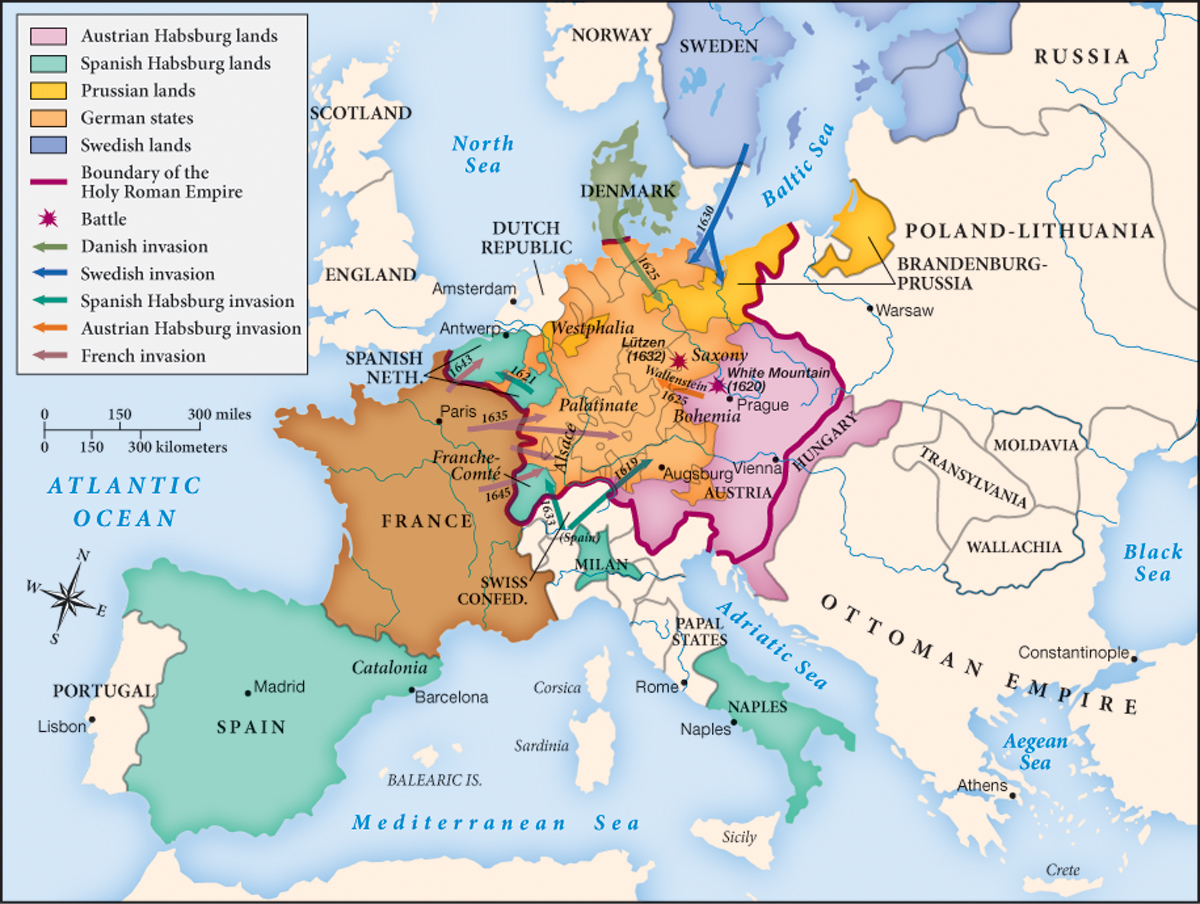The Peace of Westphalia, 1648
The Peace of Westphalia, 1648
The comprehensive settlement provided by the Peace of Westphalia—named after the German province where negotiations took place—would serve as a model for resolving future conflicts among warring European states. For the first time, a diplomatic congress convened to address international disputes, and those signing the treaties guaranteed the resulting settlement. A method still in use, the congress was the first to bring all parties together, rather than two or three at a time.
France and Sweden gained most from the Peace of Westphalia. France acquired parts of Alsace and replaced Spain as the prevailing power on the continent. Sweden took several northern territories from the Holy Roman Empire (Map 15.2). The Habsburgs lost the most. The Spanish Habsburgs recognized Dutch independence after eighty years of war. Each German prince in the Holy Roman Empire gained the right to establish Lutheranism, Catholicism, or Calvinism in his state, a right denied to Calvinist rulers by the Peace of Augsburg in 1555. The independence ceded to German princes sustained political divisions that prepared the way for the emergence of a new power, the Hohenzollern Elector of Brandenburg, who increased his territories and developed a small but effective standing army. After losing considerable territory in the west, the Austrian Habsburgs turned eastward to concentrate on restoring Catholicism to Bohemia and wresting Hungary from the Turks.

The Peace of Westphalia settled the distribution of the main religions in the Holy Roman Empire: Lutheranism would dominate in the north, Calvinism in the area of the Rhine River, and Catholicism in the south. Most of the territorial changes in Europe remained intact until the nineteenth century. In the future, international warfare would be undertaken for reasons of national security, commercial ambition, or dynastic pride rather than to enforce religious uniformity. As the politiques of the late sixteenth century had hoped, state interests now outweighed motivations of faith in political affairs.
The nearly constant warfare that preceded the peace had one surprising result: despite the death and destruction, warfare had increased state authority. As armies grew to bolster the war effort, governments needed more money and more supervisory officials. The rate of land tax paid by French peasants doubled in the eight years after France joined the war. In addition to raising taxes, governments deliberately depreciated the value of the currency, which often resulted in soaring prices. When all else failed, rulers declared bankruptcy. The Spanish government, for example, did so three times in the first half of the seventeenth century. From Portugal to Muscovy, ordinary people resisted new taxes by forming makeshift armies and battling royal forces. With their colorful banners, unlikely leaders, strange names (the Nu-Pieds, or “Barefooted,” in France, for instance), and crude weapons, the rebels usually proved no match for state armies, but they did keep troops occupied.

To meet these new demands, monarchs relied on advisers who took on the role of modern prime ministers. Louis XIII’s chief minister, Cardinal Richelieu, proclaimed the priority of raison d’état (“reason of state”), that is, the state’s interest above all else. He silenced Protestants within France because they had become too independent, and he crushed noble and popular resistance to Louis’s policies. He set up intendants—delegates from the king’s council dispatched to the provinces—to oversee police, army, and financial affairs.
REVIEW QUESTION Why did a war fought over religious differences result in stronger states?
To justify the growth of state authority and the expansion of government bureaucracies, rulers carefully cultivated their royal images. James I of England argued that he ruled by divine right and was accountable only to God: “The state of monarchy is the supremest thing on earth; for kings are not only God’s lieutenant on earth, but even by God himself they are called gods.” He advised his son to maintain a manly appearance even as some courtiers complained of his behavior toward certain male favorites. Appearance counted for so much that most rulers regulated who could wear which kinds of cloth and decoration, reserving the richest and rarest, such as ermine and gold, for themselves.